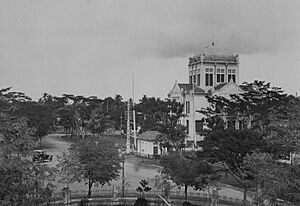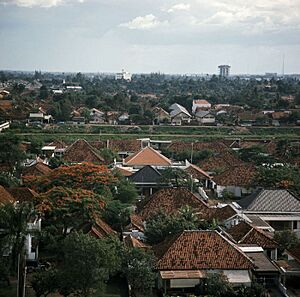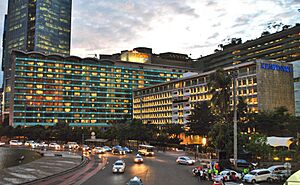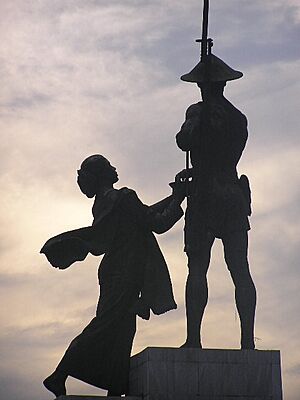Menteng facts for kids
Quick facts for kids
Menteng
|
|
|---|---|
|
District
|
|
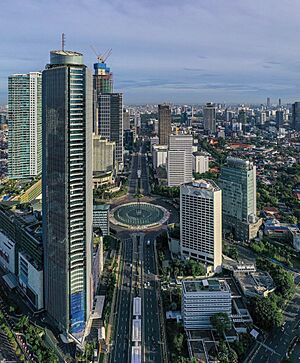
Bundaran HI, located in the eastern edge of Menteng.
|
|
| Country | Indonesia |
| Province | Jakarta |
| Administrative city | Central Jakarta |
| Postal code |
103XX
|
Menteng is a special area in Central Jakarta, Indonesia. It's known as a "district" or kecamatan. Menteng is surrounded by other districts like Senen, Matraman, Tebet, Setiabudi, Tanah Abang, and Gambir. It's bordered by the Jakarta Flood Canal to the west and the Ciliwung River to the south and east. Menteng is also where the government of Central Jakarta is located.
Menteng started as a planned neighborhood in the 1910s. It was designed as a living area for wealthy Dutch Indonesians and important officials. It was the first "garden suburb" in colonial Batavia, which is now Jakarta. Today, Menteng is one of the most expensive neighborhoods in Jakarta. This is because it's located in the "Golden Triangle," which has Jakarta's main financial areas. Many famous people have lived here, including former Indonesian presidents Suharto and Megawati Soekarnoputri. Even former US president Barack Obama spent some of his childhood here, going to local schools.
You can find train stations like Gondangdia, Sudirman, and Cikini in or near Menteng. Thamrin Road is a big street in the district, with many offices, embassies, shops, and apartments. Menteng Park is also a popular spot nearby.
Contents
Areas of Menteng
The district of Menteng is split into five smaller areas called kelurahan or subdistricts:
| Name | Area code | Notes |
|---|---|---|
| Menteng | 10310 | Includes the southern part of the original Menteng Project. |
| Pegangsaan | 10320 | This is where Indonesia's independence was declared. |
| Cikini | 10330 | |
| Kebon Sirih | 10340 | |
| Gondangdia | 10350 | Includes the northern part of the original Menteng Project. |
Menteng's Residential Area
The Menteng residential area is a special part of the Menteng district. It covers the areas of Menteng and Gondangdia. This was Jakarta's first modern housing area. It was built by a company called N.V. de Bouwploeg, started by P.A.J. Moojen in 1930. The design for Menteng was made by Moojen and F.J. Kubatz in the 1910s. Moojen was also part of a group that planned the larger Gondangdia area, with Menteng as its main part.
The Menteng Project was a very big housing plan between 1910 and 1939. It was meant to expand the city of Batavia to the south. This project focused on building homes for the upper middle class, especially Europeans, but also for some wealthy local people and Chinese residents.
Menteng's History
Before Menteng Was Built
The land where Menteng now stands used to be private estates. These estates were owned by different people over time, including a Moorish man, a Dutch family, and an Arab family. In 1890, this land was a large estate of 73 hectares, with many peasants living there. It was used for rice paddies, fields, and coconut trees.
The city of Batavia decided to buy the Menteng land to build new homes for the middle class. They also wanted to stop illegal settlements from growing there. The company De Bouwploeg bought land in Menteng and another 73 hectares from the Gondangdia estate.
How Menteng Was Developed
Moojen's first plan for Menteng was like a "garden city." This idea combines wide streets with circular roads and a central public park. At the northern entrance to Menteng, he designed important buildings like the Art Center, which was a cultural hub in early 20th-century Batavia.
The official plan for Menteng was shown in 1912. Unlike a typical garden city, Menteng was designed to connect with other nearby living areas. For example, the wide Nassau Boulevard (now Jalan Imam Bonjol) was meant to link Tanah Abang (a market) in the west with Meester Cornelis in the east. Java Street (now Jalan HOS Cokroaminoto) connected Kebon Sirih in the north to the southern edge of Batavia, which was marked by a flood canal.
Later, F.J. Kubatz changed Moojen's plan. He changed the street layout and added a small pond called Situ Lembang near the central park (now Taman Suropati). Other architects also helped shape Menteng. For example, Ghijsels designed houses in the "Indies style," St. Paul's Church, and the Logegebouw (now the Indonesian national development planning board). Another architect, J.F.L. Blankenberg, designed grand homes in Menteng, including the residence of the US Ambassador to Indonesia and the National Proclamation Museum.
Building in Menteng slowed down during the Great Depression from 1932 to 1937. During this time, some houses were built with two floors to save space. After the crisis, construction picked up again, including the building of St. Paul's Church.
Menteng After Colonial Times
After Indonesia became independent, Menteng became a prestigious area for Jakarta's local leaders. Over time, land prices in central Jakarta went up. This led to some parts of Menteng being used for businesses instead of just homes. In 1975, a rule was made to protect Menteng as a cultural heritage area because of its unique architecture, which often features high, slanting roofs and large gardens.
In the 1980s, the western part of Menteng changed into a business area. Streets like Sabang (now Agus Salim street) and Jaksa Street became home to shops, hotels, offices, and restaurants. The Jalan Jaksa Festival is held there every year. Since the 1990s, many people have tried to preserve Menteng's original design and quality.
However, protecting Menteng has faced challenges. Even though it's a heritage area, many houses have been rebuilt in a "Neoclassical" style, which doesn't fit Menteng's original early 20th-century modern look. Sometimes, new building projects continue even if they break the rules. Other problems include banning businesses in the area despite high land taxes, and a general lack of knowledge about how to preserve the old buildings.
Menteng's Design and Architecture
The Menteng project was the first housing plan in Jakarta that followed the city's first urban planning law. Menteng helped introduce a new style of architecture in the Dutch Indies called the New Indies Style. This modern style mixed older one-story villas with new two-story buildings. Houses in Menteng often had distinct roof shapes, like mansard or pyramid-shaped roofs. They also featured front terraces, large courtyards, special wall textures, and tall windows and doors for good airflow. Other popular styles in Menteng included Art Deco and Art Nouveau.
Homes in Menteng were grouped into different classes:
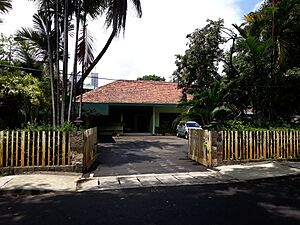
- High-class homes: These were for important officials and wealthy Dutch or European people. They were built in the main part of Menteng. Their style was a mix between the old "Oud Indische Huis" (with wide courtyards and terraces) and the more modern New Indies Style. These areas had wide boulevards. These homes were usually one or two stories tall and stood alone. Examples are the grand houses along Jalan Imam Bonjol and around Taman Suropati.
- Mid-low class homes: These were the most common types of houses in Menteng. Their style blended Dutch and local traditional houses. These areas had narrower streets. There were three types of smaller villas: Tosari, Sumenep, and Madura. They were designed with garages and servant facilities, all under 500 square meters. Some of these homes were for colonial government officials. They were usually one story and sometimes semi-detached (two homes sharing a wall).
Streets, Parks, and Facilities
The "Gondangdia Entrance" was built when Moojen designed the Bataviasche Kunstkring (1913-1914). This area, formed by what is now Jalan Cut Meutia, the railway track, and Jalan Gondangdia, is the oldest part of Menteng.
Menteng's master plan included several important facilities:
- The old N.V. de Bouwploeg Architects office, which is now the Cut Mutiah Mosque.
- The Bataviasche Kunstkring, now the Kunstkring Art Gallery.
- The Nassaukerk, now St. Paulus Church.
- A school building on HOS. Cokroaminoto Street.
- Parks covering about 30 percent of the area, including Suropati Park and Situ Lembang.
Getting Around Menteng
Menteng has good public transport, including KRL Commuterline trains, Mass Rapid Transit (MRT), and Transjakarta buses.
Commuterline Trains
- B07 Gondangdia railway station is in the northwest of the district.
- B08 Cikini railway station is in the southwest of the district.
- C12 Sudirman railway station is in the southeast of the district.
Mass Rapid Transit (MRT)
- M13 Bundaran HI MRT station is on Thamrin Road, north of Bundaran HI.
- M12 Dukuh Atas BNI MRT station is on Thamrin Road, at the eastern edge of the district.
Famous Places in Menteng
Menteng is home to many well-known landmarks:
- Canisius College
- Dukuh Atas BNI MRT station
- Cut Meutia Mosque
- Entertainment X'nter
- Gedung Joeang 45 (a historic building)
- Gedung Perintis Kemerdekaan (another historic building)
- Gondangdia Station
- Grand Hyatt and Plaza Indonesia (shopping mall)
- Hotel Indonesia, Jakarta's first luxury hotel and a famous landmark.
- Jakarta Theater
- Kunstkring Art Gallery
- Mandarin Hotel
- Megaria Theater (used to be Menteng Theater)
- Menara Thamrin (a tower)
- Menteng Park (built on the site of the old Menteng Stadium)
- Selamat Datang Monument, in the middle of Bundaran HI (Hotel Indonesia roundabout)
- Formulation of Proclamation Text Museum (Museum Perumusan Naskah Proklamasi)
- Nikko Hotel
- Patung Pahlawan (Hero's Statue)
- Sarinah (Graha Mataram)
- Sasmita Loka Ahmad Yani Museum
- Saint Paul's Church
- Saint Theresia's Church
- Sunda Kelapa Mosque
- Taman Ismail Marzuki (an arts center)
- The Hermitage Hotel, Menteng (used to be the “Telefoongebouw” and University of Bung Karno)
- Taman Suropati (a park)
- Taman Proklamasi (Proclamation Park)
- Taman Situ Lembang (a park with a pond)
Famous People Who Lived in Menteng
Many important people have called Menteng home:
- Mohammad Hatta, Indonesia's first vice president.
- Sutan Takdir Alisjahbana, a famous poet, writer, and thinker.
- Hamid II, Sultan of Pontianak, an Indonesian leader and politician.
- Loa Sek Hie, a colonial politician and landlord.
- Adam Malik, Indonesia's 3rd vice president.
- Barack Obama, the 44th president of the United States, who lived here during his childhood.
- Sutan Sjahrir, Indonesia's 1st prime minister.
- Achmad Soebardjo, Indonesia's 1st foreign minister.
- Suharto, Indonesia's 2nd president.
- Megawati Soekarnoputri, Indonesia's 5th president.
- William Soeryadjaya, a Chinese-Indonesian business leader.


